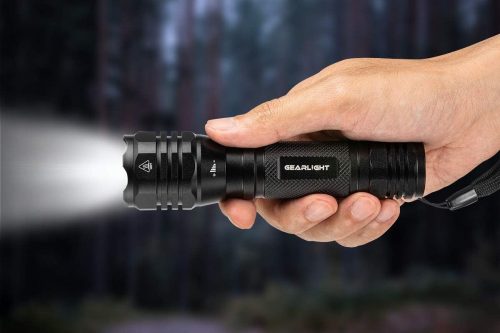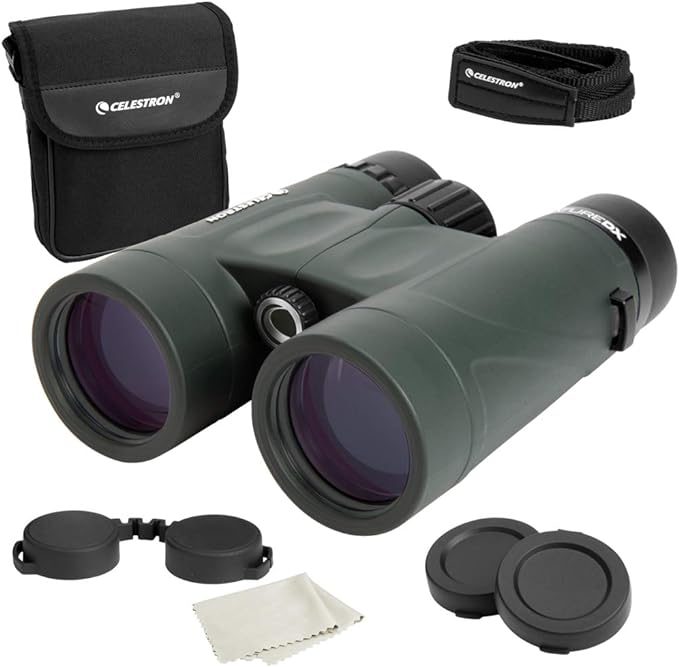Are you ready to reach for the stars and discover the mysteries of the universe? The year 2025 brings with it a new era of stargazing, and you deserve the best telescope to accompany you on this celestial journey. In this article, we will unveil the top telescopes that will transport you to new galaxies and unveil the wonders of the cosmos.
Whether you’re a beginner or an experienced stargazer, we have carefully handpicked a selection of telescopes that will ignite your sense of belonging in the vast universe. Get ready to embark on an extraordinary adventure and find the perfect telescope that will make you feel at home among the stars.
Best telescopes for stargazing in 2025
8. Telescope for Kids and Beginners
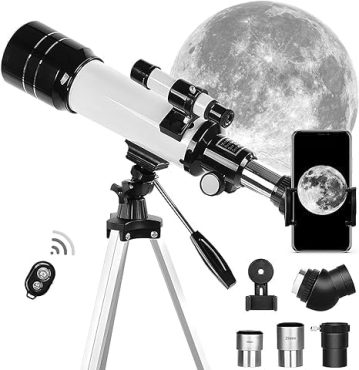
If you’re a beginner or a child interested in stargazing, the best telescopes for stargazing in 2025 offer user-friendly features and a compact design. These telescopes are designed to be easy to use and provide clear views of the night sky. With a 70mm aperture and 400mm focal length, these telescopes offer enhanced image brightness and clarity. They come with two eyepieces and a 3x Barlow lens for powerful magnification.
The telescopes are also portable and convenient, with a phone adapter and adjustable tripod included. Setting up the telescopes is a breeze, as no tools are required. With their compact and portable design, these telescopes are perfect for beginners and children who want to explore the wonders of the night sky.
- User-friendly features and compact design
- Enhanced image brightness and clarity
- Powerful magnification with two eyepieces and a 3x Barlow lens
- Portable and convenient with a phone adapter and adjustable tripod
- Easy setup with no tools required
- Limited aperture size may limit the ability to observe faint deep-sky objects
- A tripod may not be very stable, leading to shaky views
- Limited accessories and options for customization
7. Telescope 70mm Aperture 500mm

For the best telescopes for stargazing in 2025, you’ll want to consider the telescope with a 70mm aperture and 500mm focal length. This telescope offers a great balance between portability and performance. The 70mm aperture allows for decent light gathering, while the 500mm focal length provides a good magnification level for observing celestial objects.
With fully multi-coated optics, this telescope ensures clear and sharp views of the night sky. It comes with 25mm and 10mm eyepieces, as well as a 3x Barlow lens, which further enhances the magnification. The 5×24 finderscope makes it easy to locate objects in the sky.
In terms of convenience, this telescope is designed with a phone adapter, adjustable tripod, wireless remote, and carrying bag. The phone adapter allows you to capture images of what you see through the telescope, while the adjustable tripod ensures stability during observations. The wireless remote adds to the ease of use, allowing you to control the telescope from a distance.
- Decent light-gathering capability
- Good magnification level
- Clear and sharp views
- Easy object location with the finderscope
- Portable and convenient design with various accessories
- Barlow lens may reduce light and image quality
- Other objects may be more difficult to view compared to the moon
- Tripod movement may not be smooth at times
6. Telescope for Kids and Beginners

Looking for a telescope that’s perfect for kids and beginners? Look no further! The Telescope for Kids and Beginners is the ideal choice for those just starting in the world of stargazing.
With its 70mm aperture and 400mm focal length, this telescope provides bright and clear images of the moon and planets. The high transmission coated all-optical lens enhances image brightness and clarity, allowing for detailed observation. It comes with two eyepieces and a 3x Barlow lens, offering powerful magnification for a closer look at celestial objects.
The telescope is portable and convenient, with a phone adapter and adjustable tripod included. Setting up is a breeze, as no tools are required.
- Perfect for kids and beginners
- Bright and clear images
- Powerful magnification
- Portable and convenient
- Easy to set up
- Limited to lunar and planetary observation
- May require additional accessories for advanced stargazing
- The tripod may not be very sturdy.
5. ToyerBee Telescope for Adults & Kids

The ToyerBee Telescope for Adults and kids stands out for its exceptional clarity and ease of use. With its 70mm large aperture objective lens, you can expect brighter and clearer images of celestial objects. The telescope offers a magnification range of 15X-150X, thanks to the two included eyepieces and a 3X Barlow lens.
Setting up the telescope is a breeze, thanks to the adjustable tripod with a height range of 16” to 46”. Additionally, the wireless remote and smartphone adapter included in the package enhance your stargazing experience.
- Exceptional clarity and brightness
- Easy to set up and use
- Comes with a wireless remote and smartphone adapter
- Suitable for both adults and kids
- Affordable price for a quality telescope
- Fine adjustments at higher magnification levels can be challenging
- Phone adapters may require adjustments for Android phones
- Mixed experiences with the phone adapter, depending on the phone model
4. 80×100 HD Monocular Telescope
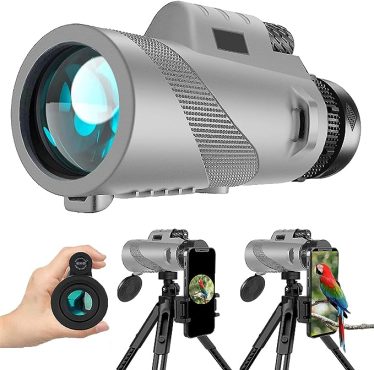
With its high power and high definition, the x100 HD Monocular Telescope offers a remarkable viewing experience for stargazers in 2025. Equipped with an FMC Superior BAK4 green film prism and a fully multi-coated lens, this telescope provides clear, high-resolution images of the night sky.
Its portable and easy-to-use design allows you to enjoy stargazing with just one hand. The telescope also comes with a smartphone adapter and tripod, making it convenient for capturing and sharing your celestial observations. The rubber housing prevents slipping and damage, while the adjustable eyecup ensures optimal viewing comfort.
Additionally, the x100 HD Monocular Telescope is suitable for a variety of outdoor activities such as hiking, hunting, and bird watching.
- High power and high definition for clear, high-resolution images
- Portable and easy-to-use design
- Comes with a smartphone adapter and tripod for capturing and sharing observations
- Rubber housing prevents slipping and damage
- Suitable for a variety of outdoor activities
- Some users may find it difficult to use the smartphone adapter and tripod attachments
- Not as powerful as stated in the description
- May not be suitable for close-up bird watching at 200ft.
3. PhysioPhyx 80×100 Monocular-Telescope

For the best telescopes for stargazing in 2025, you can’t go wrong with the PhysioPhyx 80×100 Monocular-Telescope. This high-powered monocular is compact and lightweight, making it perfect for outdoor activities such as stargazing.
It features 80×100 HD magnification, providing clear and bright images of celestial bodies. The fully coated lens ensures excellent light transmittance and image brightness, enhancing your viewing experience. The monocular also comes with a quick-positioning smartphone bracket and tripod, allowing you to easily capture and share your observations.
Whether you’re a seasoned astronomer or a beginner, the PhysioPhyx 80×100 Monocular-Telescope is a versatile and convenient tool for exploring the wonders of the night sky.
- High-powered 80×100 HD magnification
- Compact and lightweight design for easy carrying
- Quick positioning smartphone bracket and tripod included
- May not be as high-powered as expected for some users
- Limited to monocular viewing
- May require additional accessories for advanced stargazing activities.
2. Gosky Updated 20-60×80 Spotting Scopes
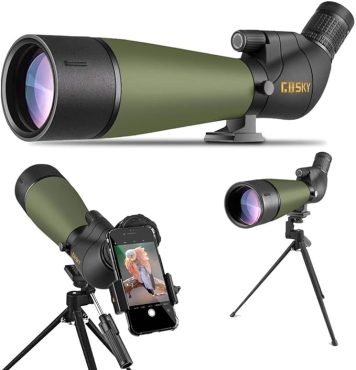
Get ready to explore the night sky with the incredible Gosky Updated 20-60×80 Spotting Scopes, the best telescopes for stargazing in 2025. These spotting scopes are perfect for astronomy enthusiasts who want to observe celestial objects with exceptional clarity and detail.
With a variable magnification range of 20x to 60x and a dynamic lens focusing system, you can easily adjust the zoom level and focus to capture breathtaking views of the stars, planets, and galaxies. The fully multi-coated 80mm green film objective lens and BAK4 Porro prism optics ensure increased light transmission and clear images, even in low light conditions. Plus, the nitrogen-filled waterproof and fog-proof design makes these spotting scopes durable and reliable in tough environments.
- Inexpensive option for stargazing
- Great zoom level for observing celestial objects
- Perfect for capturing bird identification photos
- Robust and sturdy design for outdoor use
- Fiddly phone connector for digiscoping
- Photos may not be of professional quality
- Lack of tactile indicator on the focus adjustment knob
1. Gskyer Telescope, 70mm Aperture
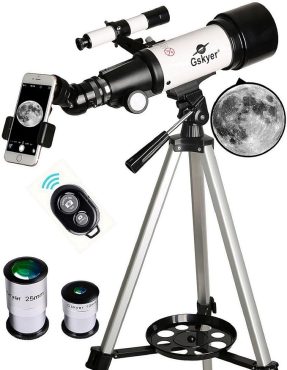
The Gskyer Telescope, with its 70mm aperture, offers stargazers a compact and portable option for observing celestial objects with clarity and precision. This refractor telescope features a 400mm focal length and fully coated optics glass lens with high transmission coatings, ensuring stunning images and eye protection. It comes with two replaceable eyepieces (25mm and 10mm) and a 3x Barlow lens for increased magnification.
The telescope also includes a 5×24 finder scope with a mounting bracket and an adjustable aluminum alloy tripod for different viewing positions. With its wireless remote and phone adapter, exploring the night sky and capturing celestial images becomes effortless. Additionally, the Gskyer Telescope comes with a carry bag for convenient transportation. Overall, this telescope provides a user-friendly experience for both beginners and experienced stargazers.
- Compact and portable design
- High-quality optics for clear views
- Wireless remote and phone adapter for easy exploration and celestial imaging
- Adjustable tripod for different viewing positions
- Convenient carry bag included
- Two-year warranty and 24/7 technical support
- Unusable 3x Barlow lens reported by some users
- Plastic wedged in the finder scope causing discomfort
- Short tripod height may lead to discomfort during observation
How to choose Best telescopes for stargazing

Power and Magnification
To choose the best telescope for stargazing, you should regularly consider the power and magnification options available. The power of a telescope determines its ability to gather light, while magnification determines how close objects appear.
When it comes to power, look for telescopes with a larger aperture, as this allows more light to enter and provides clearer views of celestial objects.
Magnification, on the other hand, is determined by the combination of the telescope’s focal length and the eyepiece used. It’s important to note that higher magnification doesn’t always mean better views, as atmospheric conditions can affect image quality. It’s recommended to choose a telescope with adjustable magnification options to suit different viewing conditions and objects of interest.
Eyepieces
If you’re looking to choose the best telescope for stargazing, one important factor to consider is the selection of eyepieces available. Eyepieces are crucial components of a telescope that determine the magnification and field of view you’ll experience.
When selecting eyepieces, you want to consider factors such as focal length, apparent field of view, and eye relief. The focal length determines the magnification, with shorter focal lengths providing higher magnification.
The apparent field of view refers to how wide the view appears through the eyepiece, with larger numbers indicating a wider field of view. Eye relief is the distance between your eye and the eyepiece, and longer eye relief is preferable for comfort.
Aperture
To choose the best telescopes for stargazing, consider the aperture, which determines the amount of light the telescope can gather and ultimately affects the clarity and brightness of the celestial objects you observe. The aperture is the diameter of the telescope’s main lens or mirror. A larger aperture allows more light to enter the telescope, resulting in brighter and more detailed views of the night sky.
The size of the aperture also determines the telescope’s ability to resolve fine details and distinguish between closely spaced objects. Generally, a larger aperture is preferred for stargazing, but it’s important to consider your specific needs and budget. Keep in mind that larger aperture telescopes tend to be bulkier and more expensive.
Mount
When considering the best telescopes for stargazing in 2025, one important aspect to consider is the mount, which plays a crucial role in providing stability and ease of use for observing celestial objects.
The mount is the component that holds the telescope and allows it to be pointed and moved smoothly. There are two main types of mounts: altazimuth and equatorial.
Altazimuth mounts are simpler and easier to use, with one axis for horizontal movement and another for vertical movement. Equatorial mounts, on the other hand, are more sophisticated and designed to align with the rotation of the Earth. They’ve two axes, one parallel to the Earth’s axis and another perpendicular to it, allowing for precise tracking of celestial objects.
When choosing a mount, consider the type of telescope you have, your level of experience, and the specific needs of your stargazing activities.
Portability
When considering the best telescopes for stargazing in 2025, prioritize portability by choosing a telescope that suits your needs and allows for easy transportation.
Portability is especially important for stargazers who want to take their telescopes to different locations to observe the night sky. Look for telescopes that are lightweight and compact, making them easy to carry and store.
Opt for a telescope with a sturdy and collapsible tripod that can be easily set up and folded down. Additionally, consider telescopes with a carrying case or backpack for added convenience.
Conclusion
Whether you’re a beginner or an experienced astronomer, we’ve got you covered. With our carefully curated list, you can find the perfect telescope that meets your needs and preferences. From powerful and advanced models to budget-friendly options, we’ve considered all the factors to ensure you have an extraordinary journey through the cosmos.
